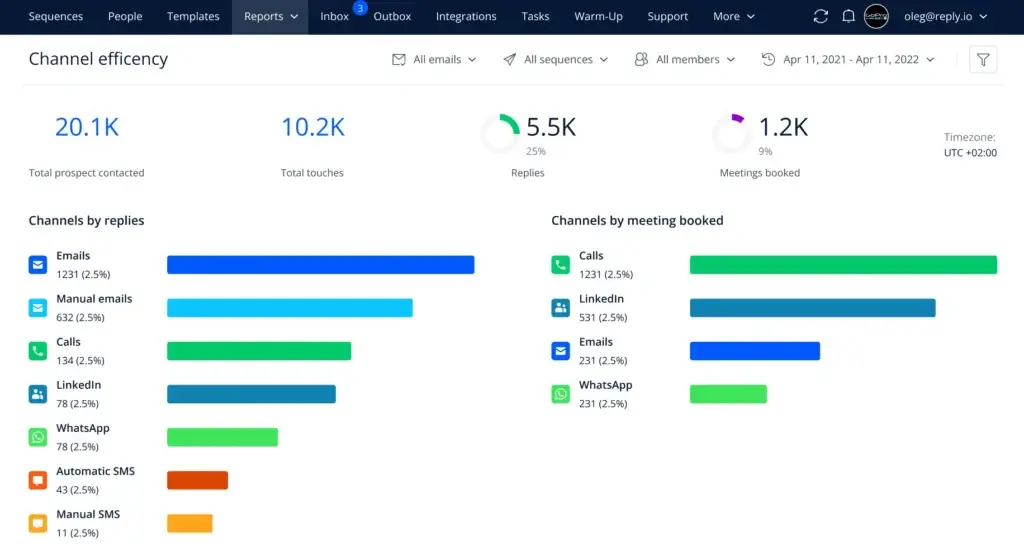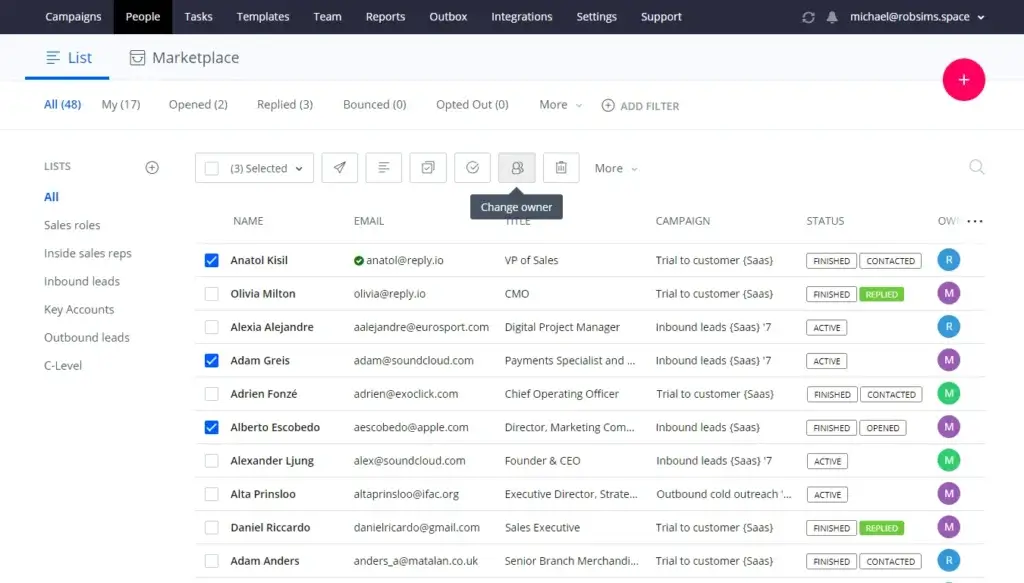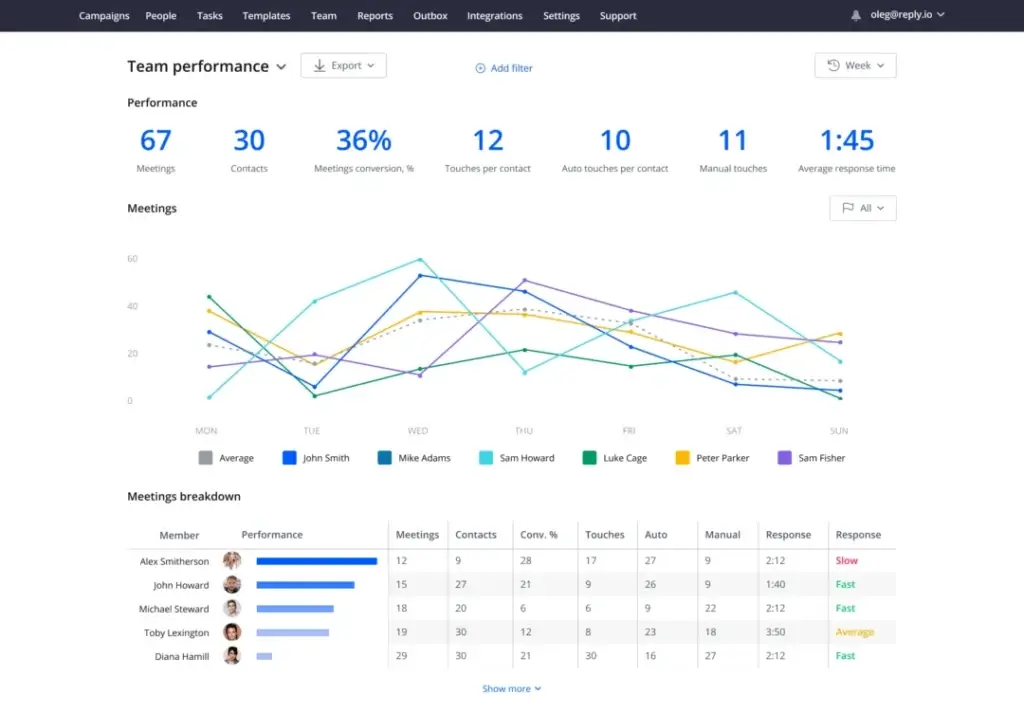Introduction
Finding and engaging the right leads is a constant challenge for B2B sales teams. Manual outreach quickly becomes time‑consuming, and poorly targeted messages lead to low response rates. Reply.io, often simply called Reply, positions itself as a comprehensive sales engagement platform that helps you automate repetitive tasks, personalize messages at scale, and reach prospects across multiple channels. In this Reply review, you’ll learn how the platform works, what it does well, where it falls short, and whether it’s the right fit for your organization.
What is Reply.io?
Reply.io is an AI‑powered sales engagement platform designed to streamline outbound outreach. It combines cold email automation with LinkedIn actions, phone calls, SMS, WhatsApp messages, and other channels. At its core, Reply aims to help sales representatives book more meetings and close deals faster by automating routine tasks and enabling personalized communication. The platform includes built‑in B2B data sourcing, AI‑driven templates, and detailed analytics, making it a single hub for your outbound workflow.
Why Choose an AI‑Driven Sales Engagement Tool?
Traditional email tools focus on sending messages, but modern sales engagement platforms go further. Reply incorporates AI to generate personalized copy, schedule follow‑ups based on recipient behavior, and adjust sequences automatically. By using AI, you can scale your outreach while maintaining a personal touch. Additionally, Reply’s multi‑channel capabilities mean you can connect with leads through their preferred channels, improving response rates and pipeline velocity.
Key Features
Reply‘s Software Specification
Reply.io packs many features into its platform, from sequence automation to data enrichment. This section breaks down the core functions to help you understand how each contributes to a successful outreach strategy.
Multi‑Channel Outreach & Sequences
Reply allows you to create multi‑step outreach sequences that combine emails, LinkedIn touches, phone calls, SMS, WhatsApp messages, and even custom tasks. Using conditional logic, you can direct prospects down different paths depending on their behavior (e.g., responses, opens, or clicks). Sequencing supports both manual and automated steps, enabling you to send personal messages when necessary while letting automation handle routine follow‑ups.
AI Variables & Personalization Tools
At the heart of Reply’s personalization lies its AI variables and copy suggestions. When crafting messages, you can insert variables that automatically pull data from a prospect’s profile (name, job title, company, industry) and even generate relevant icebreakers using Reply’s built‑in AI. The platform’s “Jason AI” assistant can draft entire sequences based on your prompts and refine copy to match your tone. For example, if you tell the assistant your goal and ideal customer profile, it produces an outreach sequence with personalized subject lines, first sentences, and follow‑up content.
Sequence Automation & Scheduling
Automation in Reply goes beyond sending a series of emails. You can set triggers and actions to adjust outreach based on prospect engagement. If a lead replies to an email, the system can automatically mark the task as complete and move to the next contact. If a lead doesn’t respond, you can schedule a reminder or send a LinkedIn connection request. For time‑based outreach, you control the cadence, scheduling messages during business hours or across different time zones to maximize deliverability and open rates.
Deliverability & Email Health Tools
Deliverability is critical in cold email outreach. Reply includes an Email Deliverability Suite with features such as SPF/DKIM/DMARC checks, custom tracking domains, and inbox warm‑up through its Mailtoaster integration. These tools ensure your emails land in prospects’ inboxes instead of spam folders. The platform also offers email validation credits to verify addresses, protecting your sender reputation. A dedicated dashboard helps you monitor bounce rates, spam scores, open rates, and reply rates so you can adapt your strategy quickly.
Reporting & Analytics
Reply’s reporting dashboard provides insights into campaign performance. You can view metrics such as delivery rates, open and click rates, replies, meetings booked, and time‑to‑response across channels. Channel‑specific dashboards allow you to compare performance between email, LinkedIn, SMS, calls, and WhatsApp. Team reporting features help managers track individual reps’ activity and identify which sequences drive the most engagement. These analytics enable data‑driven decisions to refine your outreach.
Integrations & Lead Management
Reply integrates with more than 100 CRM and sales tools, including Salesforce, HubSpot, Pipedrive, Zoho CRM, Copper, and others. Through Zapier and native APIs, you can sync contacts, update lead statuses, and trigger sequences based on CRM events. The built‑in Findy Chrome extension lets you capture verified contact data from LinkedIn and the web, adding it directly to your sequences or CRM. Additionally, Reply’s database of verified B2B contacts (over a billion contacts according to user reports) reduces the need for third‑party data providers.
AI SDR & Jason AI
A standout feature is Jason AI, an intelligent sales development representative (SDR) assistant. Jason AI can learn about your product, identify relevant prospects, personalize messages in multiple languages, and even handle responses. Essentially, Jason AI can conduct outreach on your behalf, gather replies, and book meetings, acting as a virtual SDR. For teams with limited bandwidth, this feature can accelerate pipeline generation.

Pros and Cons
Benefits of Using Reply.io
Positive
✅ Ease of use
✅ Powerful automation
✅ AI‑driven personalization
✅ Deliverability tools
Negative
❌ Pricing complexity
❌ Learning curve for advanced features
❌ Software bugs and browser extension glitches
❌ Limited integrations with certain tools
While Reply offers robust functionality, no tool is perfect. Here’s a balanced look at what users appreciate and where they encounter challenges.
✅ Pros
- Ease of use: Many users report that Reply’s interface is intuitive and quick to learn, even for non‑technical sales reps.
- Powerful automation: Multichannel sequences and conditional logic save time by automating repetitive tasks.
- AI‑driven personalization: The built‑in AI helps create relevant and compelling outreach messages, improving response rates.
- Deliverability tools: SPF/DKIM checks, inbox warm‑up and email validation protect sender reputation and boost email deliverability.
- Comprehensive reporting: Channel‑specific dashboards provide actionable insights for data‑driven decision making.
- Large contact database: Integrated data search eliminates the need for separate prospecting tools.
❌ Cons
- Pricing complexity: Some users feel that Reply’s pricing is high, especially when adding multiple mailboxes or paying for extras like email validation credits.
- Learning curve for advanced features: Setting up complex sequences and AI SDR workflows may require training and experimentation.
- Software bugs and browser extension glitches: Occasional errors in the Chrome extension and deliverability issues can disrupt workflows.
- Limited integrations with certain tools: Users note gaps when integrating with calendars or specific CRMs, such as Outlook or Pipedrive.
- Customer support responsiveness: Support is primarily email‑based; real‑time chat or phone support may be limited compared to competitors.
How Reply Works
The Mechanism Behind Reply.io
Understanding the typical user workflow will help you decide how easily Reply can fit into your sales processes.
Onboarding & Setup
Getting started begins with signing up for a free trial and connecting your work email. Reply walks you through an onboarding wizard where you set up your sender identities, import or source leads, and define your ideal customer profiles. You can select pre‑built templates or begin with the AI assistant to generate outreach copy. The platform also checks your domain configuration (SPF, DKIM, DMARC) to ensure optimal deliverability before you launch campaigns.
Building Your Ideal Customer Profile
To achieve high response rates, you need a clear understanding of whom you’re targeting. Reply’s integrated database allows you to filter leads by industry, company size, job role, geographic region, revenue, technology stack, and more. You can save multiple Ideal Customer Profile (ICP) templates for different segments – for example, separate profiles for mid‑market SaaS companies and enterprise healthcare providers. Once defined, these profiles automatically populate lists that feed into your sequences.
Using Sequences & Jason AI
After defining your ICP, you build your outreach sequences. Choose from existing templates or ask Jason AI to generate a sequence tailored to your goals. Insert AI variables to personalise each step, and specify conditions that determine the next action based on prospect engagement. For example, if a prospect opens an email but doesn’t reply within 48 hours, the system can automatically send a LinkedIn connection request. Jason AI can also respond to incoming messages with suggested replies and schedule meetings on your behalf.
Monitoring & Optimizing Campaigns
Once your sequences go live, monitoring performance is straightforward. Reply’s dashboards show real‑time metrics across each channel, allowing you to identify which subject lines, templates, and time slots drive the highest engagement. You can clone and tweak high‑performing sequences, adjust sending windows, or experiment with new messaging. Team managers can compare reps’ performance and provide coaching based on data, ensuring consistent improvement across the sales organisation.

Business size fit
Who Should Use Reply?
Reply.io suits a range of organisations, but it shines most for certain teams and industries. Determining if it matches your needs depends on your business size, sales process, and technical resources.
Who Should Use Reply.io?
- B2B sales teams: If your team relies on outbound prospecting, Reply helps you automate follow‑ups and personalise messages, freeing reps to focus on high‑value conversations.
- Agencies managing client outreach: Agencies can run separate workspaces for each client, create custom sequences, and track performance via team dashboards.
- Recruiters and HR professionals: Multichannel sequences can help recruiters engage candidates across email, LinkedIn, and SMS.
- Founders and solo entrepreneurs: Small teams that need to scale outreach without hiring additional SDRs benefit from AI‑driven automation.
Use Cases by Company Size
- Start‑ups: Quickly build prospect lists, test different segments, and automate early outreach without investing heavily in staff or infrastructure.
- Mid‑sized firms: Use Reply to run multi‑channel campaigns, coordinate team members, and integrate with CRM systems for a unified workflow.
- Enterprises: Deploy Reply to enhance existing sales processes, especially when using AI SDR to complement human reps. Large teams can utilise advanced reporting and role‑based permissions for governance.
Pricing and Plans
How much does Reply.io cost?
Reply’s pricing structure includes a free tier and several paid plans, each with different feature sets and limitations. Understanding these tiers will help you estimate your total cost of ownership.
Free & Starter Plans
The Free Plan lets you test core features with limited email sending and a small number of data credits. It includes a sequence generator, 200 data search credits, Jason AI access, and a Chrome extension. The Starter Plan (around $49 per user per month when billed annually) adds a single mailbox, 5,000 data search credits, basic reporting, and integrations with HubSpot and Pipedrive. You also get 50 AI personalization credits for customizing messages.
Multichannel & Professional Plans
The Email Blast and Multichannel Plans expand sending capacity and channels. The Email Blast plan (around $179 per month) allows unlimited mailboxes and up to 50,000 active contacts, with optional add‑ons for LinkedIn, calls, and SMS. The Multichannel plan (from $99 per user per month) includes five mailboxes per user, 200 live data credits, and full multi‑channel sequencing across email, LinkedIn, SMS, calls, and WhatsApp. Features like team performance dashboards, CSV exports, and dedicated onboarding make it suitable for collaborative teams.
AI SDR & Enterprise Plans
For companies seeking full automation, Reply offers AI SDR plans starting around $500 per month for 500 contacts. These packages provide unlimited users, advanced automation, and access to the Jason AI assistant. Higher tiers include AI SDR Growth ($2,500 per month for 5,000 contacts) and AI SDR Enterprise (custom pricing for 25,000+ contacts). These plans come with additional support, custom playbooks, and Slack integration. Agencies can opt for the Agency Starter (around $166 per month) or Agency Advanced plans, which offer unlimited client workspaces, white‑label options, and premium support via Slack.
Value & Return on Investment
When evaluating Reply’s cost, consider both the subscription price and optional add‑ons like extra mailboxes, email warm‑up, or additional data credits. According to user reports, Reply can dramatically reduce time spent on manual outreach and improve conversion rates. However, small teams may find the pricing high relative to the feature usage. Assess your outreach volume, team size, and expected efficiency gains to determine whether the investment makes sense.
Alternatives & Competitor Comparison
If you’re comparing Reply to other sales engagement tools, it’s helpful to understand how the feature sets and pricing differ. Below is a simplified comparison between Reply and two notable competitors: Apollo.io and Salesloft. Use this as a high‑level overview; exact pricing and features may vary by plan.
| Feature Type | Reply.io | Apollo.io |
| Contact Database | 1B+ B2B contacts integrated | 210M contacts, 35M companies |
| Multi‑Channel Sequences | Email, LinkedIn, SMS, WhatsApp, calls | Email, calls, LinkedIn (limited) |
| AI Personalization | Jason AI for sequence creation & responses | AI recommendations for next steps |
| Email Deliverability | Warm‑up, SPF/DKIM checks, validation credits | Basic deliverability tools |
| Pricing (Entry Plan) | From $49/user/month (Starter) | From $49/user/month |
| Integrations | Salesforce, HubSpot, Pipedrive, Zoho, Zapier | Salesforce, HubSpot, Outreach, Zapier |
| AI SDR | Fully automated outreach from $500/month | Not offered |
Where Reply Stands Out
Reply distinguishes itself with its AI SDR capability and built‑in database, which can significantly reduce the need for external tools. Its focus on email deliverability, warm‑up services, and multi‑channel flexibility also makes it attractive for teams seeking an all‑in‑one solution.
When to Consider Alternatives
If you require deeper CRM integrations, advanced analytics, or more mature ecosystems, tools like Apollo or Salesloft may be better suited. Smaller teams on a strict budget might also explore options like Lemlist or Salesrobot, which offer comparable multi‑channel outreach at lower price points.
Integration & Compatibility
How Reply Works with Other Tools
Integration capabilities can make or break a sales engagement platform. Reply scores well here, although there are a few gaps.
CRM & Sales Tools
Native integrations connect Reply to popular CRMs such as Salesforce, HubSpot, Pipedrive, Zoho CRM, Copper, and more. These integrations allow you to sync contacts, update deal stages, log activity, and trigger sequences based on CRM events. Reply also integrates with sales intelligence platforms like ZoomInfo and data enrichment tools, though some advanced functions may require API access or Zapier.
Email & Communication Channels
Reply supports Gmail, Outlook, and other SMTP/IMAP providers for sending emails. You can connect multiple mailboxes and assign them to different sequences or team members. The platform also offers dialer functionality for phone calls, SMS integration, WhatsApp messaging, and LinkedIn automation. Keep in mind that some users report limitations when connecting with certain calendar tools or needing additional configuration for Microsoft Outlook.
Data & API Integration
Reply’s API allows developers to add leads to sequences, fetch performance metrics, and create custom workflows. Through Zapier, Make, and n8n connectors, you can link Reply with more than 200 applications, including Slack, Trello, Google Sheets, and marketing automation platforms. While data import from CSV is straightforward, exporting detailed activity data back into your CRM can be more challenging and may require custom scripting.

Conclusion
Final thoughts
Reply.io has evolved into a robust sales engagement platform that marries AI‑driven personalization with multi‑channel outreach and data enrichment. Its strengths lie in ease of use, comprehensive automation, strong deliverability tools, and an AI SDR option that can handle outreach end‑to‑end. The platform can save you hours each week and elevate your outbound strategy by providing data insights and streamlined workflows.
However, the tool isn’t without drawbacks. Pricing can climb quickly as you add mailboxes or contacts, and some users experience bugs or integration issues. The learning curve for advanced features and the reliance on email‑based support may frustrate teams that need hands‑on assistance.
Should you choose Reply? If your sales or marketing team is ready to invest in a powerful platform that automates multi‑channel outreach and leverages AI for personalization, Reply is a strong contender. It’s particularly beneficial for mid‑sized and enterprise teams looking to scale outbound efforts without hiring an army of SDRs. For small businesses or those requiring heavy integrations with specific tools, exploring alternatives may be worthwhile.
Have more questions?
Frequently Asked Questions
What makes Reply.io different from a regular email automation tool?
Reply.io goes beyond simple email automation by offering multi‑channel sequences (email, LinkedIn, SMS, calls, WhatsApp), AI‑generated personalization, an integrated B2B database, and robust deliverability tools. This combination lets you reach prospects through multiple channels while maintaining a personal touch.
Is Reply.io suitable for small businesses?
Reply can be a great option for small businesses that need to scale outreach quickly. However, the cost may be high for very small teams, especially if you require multiple mailboxes or advanced features. Evaluate your volume of outreach and budget before committing.
Does Reply.io include a free plan?
Yes. Reply offers a free plan that provides limited email sending, 200 data search credits, and access to the Jason AI sequence generator. It’s a good way to test the platform before upgrading to a paid plan.
Can I use Reply.io with my existing CRM?
Reply integrates with popular CRMs such as Salesforce, HubSpot, Pipedrive, Zoho, and Copper. Through native integrations or connectors like Zapier, you can sync contacts, update lead statuses, and trigger sequences based on CRM events.
What is Jason AI in Reply.io?
Jason AI is Reply’s AI‑powered assistant that helps you create and personalize sequences, draft individual messages, and even respond to prospects. For higher‑tier plans, Jason AI can serve as a virtual SDR, handling outreach and booking meetings on your behalf.
How does Reply ensure email deliverability?
Reply includes tools to warm up your inbox, authenticate domains (SPF, DKIM, DMARC), and validate email addresses. These features help improve sender reputation and ensure your emails reach inboxes rather than spam folders.
Are there any notable issues with Reply.io?
Users occasionally report software bugs, glitches in the Chrome extension, and limited integrations with some tools like calendars or Outlook. Pricing can also be a barrier for small teams, and customer support is mostly via email.
Can I customize sequences based on prospect behavior?
Yes. Reply allows you to set conditional logic in sequences. For example, if a prospect opens an email but doesn’t reply, the next step could be a LinkedIn message. If a prospect replies, the sequence can automatically stop or switch to a different path.
What are the main alternatives to Reply.io?
Popular alternatives include Apollo.io, Salesloft, Lemlist, and Salesrobot. Each offers variations in pricing, features, and integrations. Apollo has a large contact database and strong analytics; Salesloft excels in enterprise‑grade features; Lemlist focuses on affordable multichannel outreach; Salesrobot touts reliable LinkedIn automation.
Is Reply.io worth it?
Reply offers a comprehensive set of tools to automate outreach, personalise messages, and improve deliverability. For teams that need these capabilities and can justify the cost, it’s a powerful solution. However, if you’re on a tight budget or require niche integrations, consider testing the free plan first and comparing alternatives.








